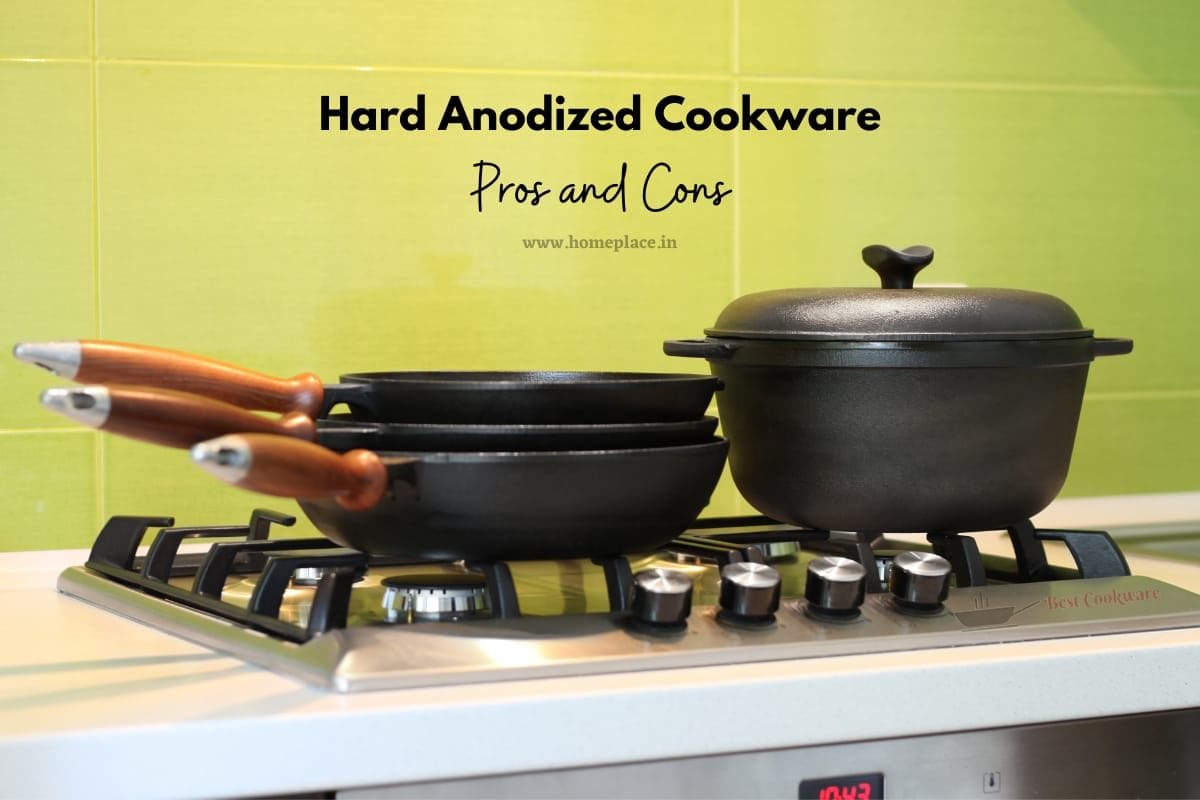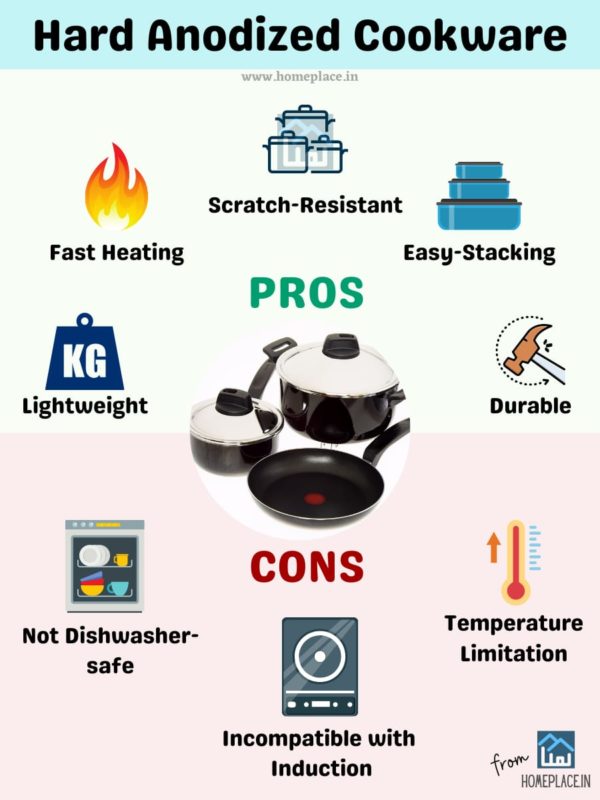Hard anodized cookware is trending for its robust build quality and attractive appearance at a reasonable price. It is an ideal alternative to stainless steel, cast iron, and traditional aluminum cookware.
Aluminum is the base for all hard anodized cookware, which is anodized to make the surface food-safe and non-reactive. Besides these benefits, there are also some drawbacks you should not ignore. In this article, you will learn about the unique advantages and critical disadvantages of hard anodized cookware that decide its worthiness.

What is hard anodized cookware?
Hard anodized cookware is a special type of aluminum cookware with its surface anodized in an electrochemical process to provide a non-reactive and food-safe surface with improved hardness and wear resistance.
This anodized layer combined with a non-stick coating makes the best hard anodized cookware rust-free, scratch-resistant, and non-stick. Let’s check the benefits you can get from this cookware.
Advantages of hard anodized cookware
1. Hard anodized cookware is highly durable
Hard anodized pots, pans, tawa, and pressure cookers have a layer of non-reactive anodic oxide. Aluminum creates a solid oxidized exterior coating on the cookware surface in the electrochemical process. The material becomes corrosion-resistant and durable with an improved hardness and resistance to wear and tear.
2. It has high thermal conductivity for efficient cooking
Aluminum is an excellent conductor of heat with a thermal conductivity coefficient of 239 W m −1 K −1, making the utensils heat up quickly, unlike other cookware. For this reason, anodized aluminum cooks more tender and soft food like fish and chicken, and also, the cooking time reduces by quick heating.
3. Hard anodized cookware is scratch-resistant
The kitchen utensils tend to get scratches and dings while working. The hard anodized surface makes the kitchenware tough and resistant to scratches, making the cookware smooth for a longer period.
4. You can easily stack and store it after use
You can store the utensils easily in any cabinet and shelf for its lightweight. Also, the sleek design makes it easy to stack and store in modular kitchens.
5. Hard anodized material is non-reactive and food-safe
The hard anodized coating on this cookware doesn’t react or leach metals into food. For example, acidic food like lemon juice and vinegar doesn’t react with the hard anodized surface. It doesn’t let the metal rust or corrode, making it safe to use.
6. Non-stick coating makes it easy to use
Hard anodized cookware is coated with Polytetrafluoroethylene (PTFE) or ceramic materials to make it non-stick. Thus, the food doesn’t get stuck at the bottom, making it easy to clean. The cleaning becomes smooth, and you don’t have to scrub your cookware vigorously.
Apart from it, you can use less oil while cooking on hard anodized kadai or pan. The cookware’s non-stick surface helps you cook food with the slightest use of butter and oil, and it encourages healthy cooking and eating habits.
7. It needs less maintenance and no seasoning
Hard-anodized cookware doesn’t need seasoning like cast iron cookware. For long-term use, these are an excellent choice for your kitchen. As food particles do not stick on the cookware surface, it is easy to clean and maintain.
8. Hard anodized cookware is highly affordable.
Most hard anodized cookware is more affordable than stainless steel cookware. For example, Vinod’s 2.5 L stainless steel kadai costs around ₹3650, whereas Hawkins’ Futura hard anodized cookware is priced around ₹1470, which is almost half.
Disadvantages of hard anodized cookware
1. Hard anodized cookware is not dishwasher-safe
Non-stick coating and hard anodized aluminum metal should be hand washed. The harsh chemicals and hot water in the dishwasher can damage the coating. Always use a non-abrasive scrubber and soaps during washing.
2. Not ideal for cooking at high temperature over 260°C
A temperature over 260°C is generally incompatible with hard anodized cookware. Also, the non-stick coating starts to break down above 300°C, leaching harmful substances. In comparison, stainless steel cookware can handle temperatures up to 315°C.
3. Incompatibility with induction cooktops
Most hard anodized tawa and pans do not work with induction cooktops, and you need cookware with a magnetic bottom. Hard anodized cookware with a magnetic metal disc attached to the bottom is compatible with inductions.

So, is it worth buying hard anodized cookware?
From the advantages and disadvantages of hard anodized cookware, you can now make a thoughtful decision if you should get it. This type of cookware is versatile, lightweight, durable, and safe to use on the gas stove and induction cooktop with a ferromagnetic base.
The hard anodized cookware can last for a long time for its hardness and wear-resistant quality. The scratch-free and rust-free nature make it easy to store in cupboards, racks, or cabinets, depending on your kitchen design.
So, overall, hard anodized cookware is definitely worthy of buying. If you are looking for stylish cookware, the best ceramic cookware can also be your go-to product.
